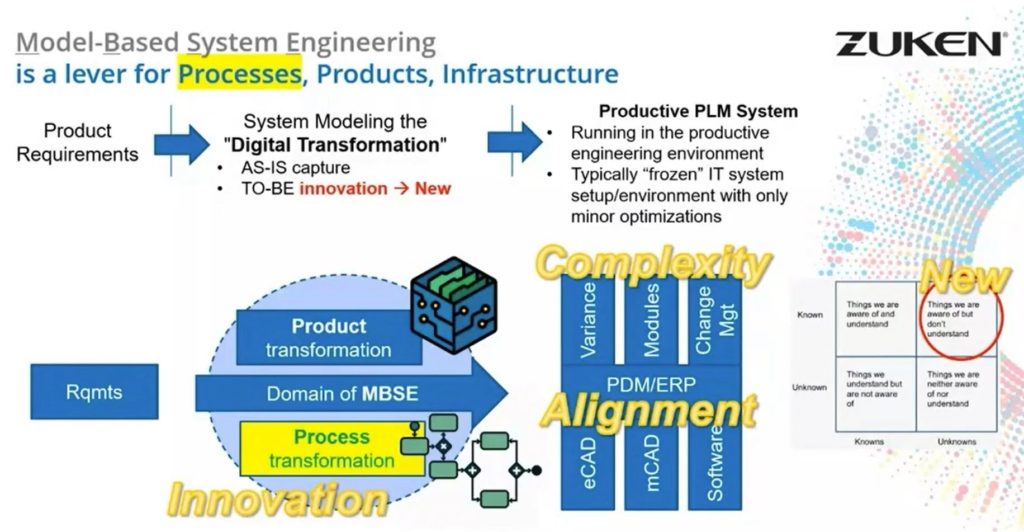Model-Based Systems Engineering (MBSE) has met a growing interest over recent years and is often seen as a method to resolve system complexity and shave off a significant time of the product development process. The growing complexity of cyber-physical systems in modern machinery and equipment has fueled its adoption, not only in the aerospace industry, where the method originated but across a variety of industries, such as automotive and industrial machinery.
Model-based systems engineering is a formalized methodology that is used to support the requirements, design, analysis, verification, and validation associated with the development of complex systems. In contrast to document-centric engineering, MBSE puts models at the center of system design.¹
A model is an organized structure of descriptions and relationships that can be broken down into any level of detail. The relationships and behavioral specifications that are captured in each element of the overall model can be used to simulate and verify their interaction on a system level – and to trace the ripple effects of change across the entire system.
In any quest for innovative approaches and solutions, a modeling tool provides advantages that document-based systems engineering cannot provide.
As before any decision, however, you should ask yourself a few questions to define the goals of introducing a new methodology and formulate a clear strategy around it.
How do I know if MBSE is right for my organization?
Before implementing a new methodology in the area of product development, we must ask ourselves one central question: is this method applicable to my system size and complexity? Unfortunately, there is no best practice figure that tells you “yes, MBSE is beneficial, if your system is this particular size and reaches this level of complexity”. As a rule of thumb, it can be stated that MBSE is an option in all cases where new approaches and radical innovations are to be investigated. It is less useful to describe an established and proven process in a quest for increased efficiency.
However, in any quest for innovative approaches and solutions, a modeling tool provides advantages that document-based systems engineering cannot provide.²
Whenever stakeholders from different disciplines and backgrounds need to be coordinated in an unequivocal and efficient way, an MBSE tool such as GENESYS from Zuken can provide a valuable and reliable reference as it is able to capture and analyze the system’s design specifications from various stakeholder views, such as system behavior, software, hardware, safety, security, or other disciplines.
When using an MBSE software tool, a single source of truth is built in which discipline-specific views of the system are created of the same model data. This guarantees that the latest information is made available to everyone working on a project, displayed in a way that is meaningful to them.
In very few organizations all processes and practices are consistently defined and documented: there are hidden process breaks that are bridged by knowledgeable staff, and some practices are not formalized at all. To innovate, it is essential to know the current state before you set out to transform it into the desired state. A methodical approach like MBSE can create the transparency that is needed to take the development of complex systems and processes to the next level.
Making a big splash with MBSE
It is also helpful to take a closer look at the innovation process in product development before deciding on an MBSE tool. The core idea of radical innovation is the creation of new knowledge and the commercialization of completely novel ideas, that can be used to create a product that has never existed before – like the first iPhone, paving the way for today’s smartphone market.
GENESYS enables teamwork across all disciplines. This shared modeling environment improves the analysis of the system and reduces the number of defects that are commonly injected in a traditional document-based approach.
Radical innovation relies on organizational human capital, but also an organization’s capabilities to foster innovation by connecting the ideas from different disciplines to create something completely new. This novelty then has to be defined and simulated to verify whether it will actually work. Therefore, a business model centered around radical innovation is more likely to draw bigger benefits from MBSE than incremental innovation, where there are already empirical values for how certain changes will affect the overall system.
Incremental innovations refine and improve existing concepts and help organizations stay competitive in the short term but don’t necessarily make a big splash. Radical innovation focuses on the long-term impact. This means it is a good idea for any organization to consider displacing current products and creating new product categories without the fear of change in relations between customers and suppliers to stay competitive over time and reach long-term goals. And now we have come full circle on the fact that the introduction of MBSE and the investment into a modern tool is an idea worth considering.
Reduce development risks by sharing a digital modeling environment across disciplines
Our MBSE tool GENESYS has been designed specifically for collaborative teamwork supporting concurrent contribution and live updating so that all team members are drawing data from the same single source of truth. It helps authors break down documents into a system of models which can be used to analyze the ripple effect of change on the overall system. With this real-time collaboration capability, development projects can be significantly accelerated and become more robust with data that reflects the most up-to-date information at any given point.
With these capabilities, GENESYS enables teamwork across all disciplines. This shared modeling environment improves the analysis of the system and reduces the number of defects that are commonly injected in a traditional document-based approach. The availability of digitalized system data for analysis across disciplines provides consistent propagation of corrections and incorporation of new information and design decisions.
References:
1 https://en.wikipedia.org/wiki/Model-based_systems_engineering
2 http://insights.sei.cmu.edu/blog/introduction-model-based-systems-engineering-mbse/







